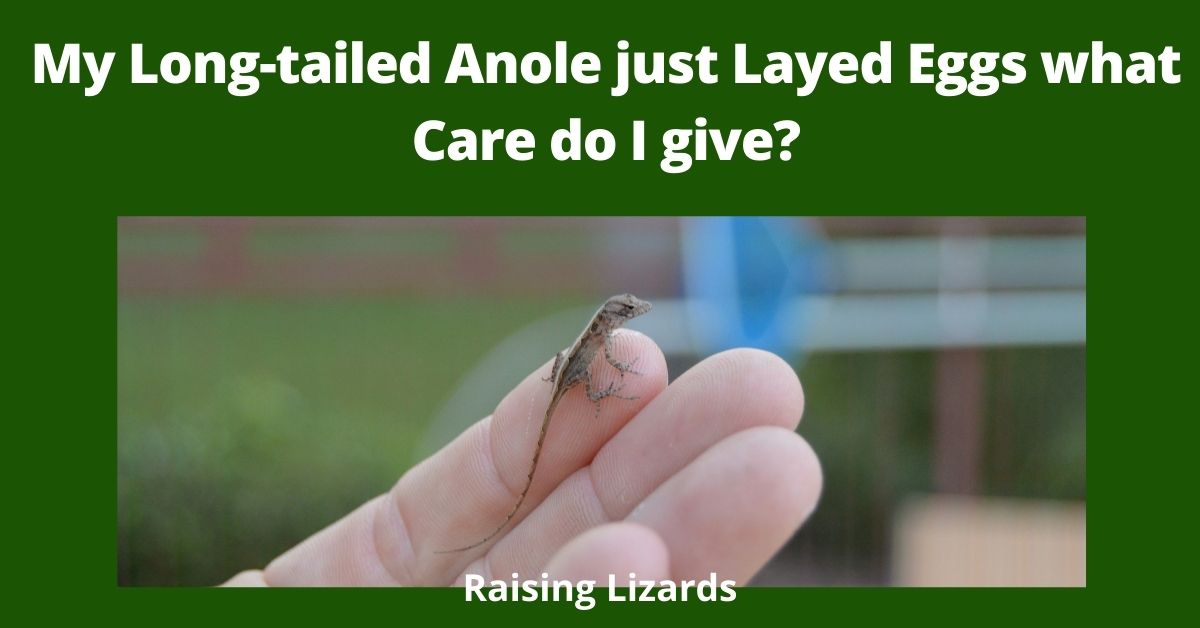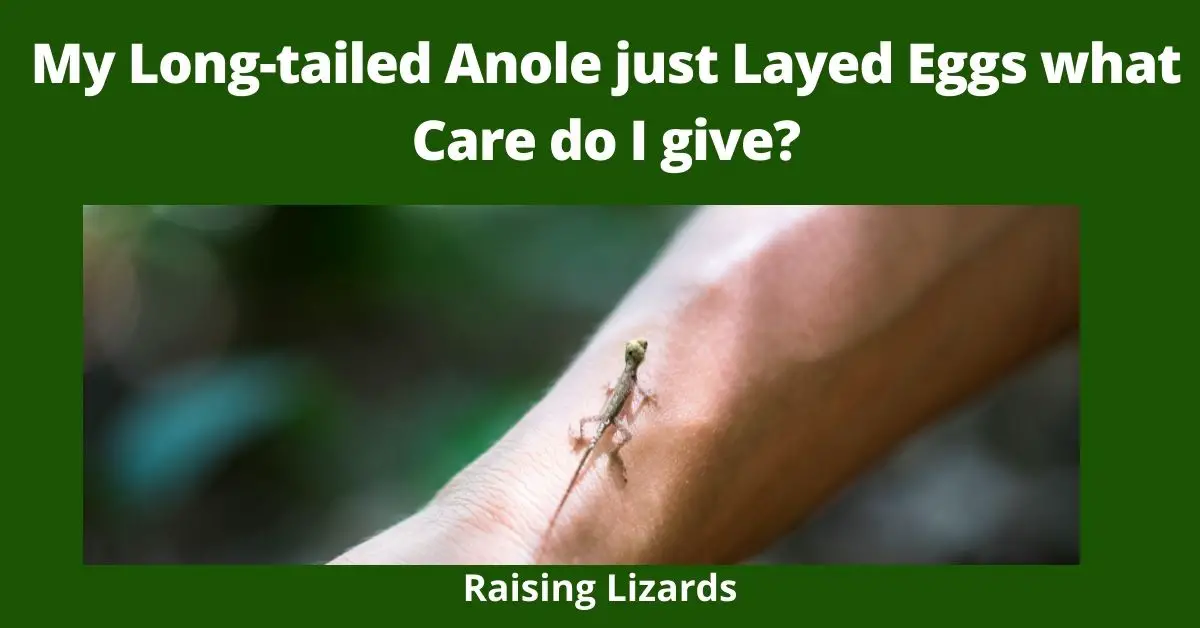If you maintain a consistent temperature and humidity level, the eggs should hatch within six to eight weeks. Once they have hatched, you will need to provide the same basic care as you would for an adult Anole.
My Long-tailed Anole just Layed Eggs what Care do I give?
My long-tailed anole just laid eggs! What do I do now? This is a question that many new reptile owners find themselves asking. It can be confusing trying to figure out how to take care of your new little family but don’t worry, we’re here to help. In this blog post, we will discuss the basics of taking care of newly-laid anole eggs. Jump to Anole Eggs – Do Anoles Lay Unfertilized Eggs?
How Many Eggs Will my Long-tailed Anole Lay?
A female Anole will typically lay anywhere from two to eight eggs at a time. However, it is not uncommon for a female to lay up to twelve eggs. If this is your first time caring for Anole eggs, we recommend starting with a smaller clutch (two to four eggs). This will make it easier to keep track of the eggs and provide them with the proper care. My Long-tailed Anole just Layed Eggs what Care do I give?

How often do a Female anole Lay and Egg?
A female Anole will typically lay an egg every seven to ten days. However, this can vary depending on the individual reptile. Some females may lay more frequently, while others may take longer between clutches. If you are unsure how often your Anole is laying eggs, it is best to consult with a reptile veterinarian.
The first step is to make sure the eggs are safe from predators.
One of the most important steps in taking care of newly-laid Anole eggs is making sure they are safe from predators. If you have other pets in your homes, such as dogs or cats, it is important to keep them away from the eggs. You will also need to make sure the eggs are kept in a secure enclosure where other animals cannot get to them. Once the eggs have been protected, you’ll need to provide some basic care.
Make sure the eggs are kept at a consistent temperature.
Anoles require a warm environment, and their eggs are no different. The ideal temperature for incubating Anole eggs is between 78 and 82 degrees Fahrenheit. Make sure to place the eggs in an area where they will be consistently warm. If the temperature varies too much, it could result in developmental problems for the embryos.
Keep the humidity level in the incubation area high.
The Humidity % is critical to the success of hatching eggs, and is often more critical than Temperature. The humidity level in the incubation area should be kept at around 80%. This will help keep the eggs healthy and prevent them from drying out.
Turn the eggs regularly.
Another important step in taking care of Anole eggs is turning them regularly. This helps ensure that all embryos develop evenly and prevents any from becoming stuck to the side of the eggshell. Turning the eggs should be done every other day or so. If you are unable to turn them yourself, you can ask a friend or family member to help out.
If you maintain a consistent temperature and humidity level, the eggs should hatch within six to eight weeks. Once they have hatched, you will need to provide the same basic care as you would for an adult Anole. This includes a warm environment, high humidity, and a variety of insects to eat. If you have any questions about caring for your newly-hatched Anoles, feel free to contact a reptile veterinarian. Thanks for
How do I care for the Baby Anoles?
- Brooder – A brooder is an enclosed space where you will keep your baby anoles until they are old enough to be moved into their permanent enclosure. The brooder should have a warm, humid environment similar to the one they were born in. You will also need to provide a variety of small insects for them to eat.
- Permanent Enclosure – Once the baby anoles are big enough, they can be moved into their permanent enclosure. This should be set up similar to their brooder, with a warm, humid environment and plenty of small insects to eat. As they grow older, you can gradually increase the size of the insects they are eating.
- Temperature – Anoles require a warm environment, and their eggs are no different. The ideal temperature for incubating Anole eggs is between 78 and 82 degrees Fahrenheit. Make sure to place the eggs in an area where they will be consistently warm. If the temperature varies too much, it could result in developmental problems for the embryos.
- Humidity – The humidity level in the incubation area should be kept at around 80%. This will help keep the eggs healthy and prevent them from drying out.
- Feeding – A variety of small insects should be provided for baby anoles to eat. As they grow older, you can gradually increase the size of the insects they are eating. Adult anoles typically eat crickets, roaches, and other small insects.
- Food Water – Anoles require a water dish that is big enough for them to soak in. The water should be changed daily, and the dish should be cleaned regularly to prevent bacteria from growing.

What is the Life Cycle of The Green Anole Lizards?
The green anole lizard is a North American species of lizard that is found in the southeastern United States. These lizards are diurnal, which means they are active during the day. They can be seen perched on trees or shrubs, where they wait for their prey to come within striking distance.
Green anoles are sexually dimorphic, which means the males and females look different from each other. Males have a bright green coloration, while females are typically brown or gray.
The mating season for green anoles usually begins in late spring and lasts through summer. During this time, the males will court the females by singing and displaying their brightly-colored body parts. After mating, the female will lay eggs in a safe location.
The eggs will hatch a few weeks later, and the baby anoles will stay in the nest until they are big enough to fend for themselves. Green anole lizards can live up to six years in the wild.
What do I do if My Anole’s Eggshell is Cracked?
If you find that one of your anole’s eggs has a cracked shell, there are a few things you can do to help protect it. The first step is to make sure the eggs are safe from predators. If there are any other eggs in the clutch, move them all to a safer location.
Once the eggs have been protected, you’ll need to provide some basic care. Make sure the eggs are kept at a consistent temperature and the humidity level in the incubation area is high. You will also need to turn the eggs regularly.
Final Thoughts – My Long-tailed Anole just Layed Eggs what Care do I give?
If you maintain a consistent temperature and humidity level, the eggs should hatch within six to eight weeks. Once they have hatched, you will need to provide the same basic care as you would for an adult Anole. This includes a warm environment, high humidity, and a variety of insects to eat. If you have any questions about caring for your newly-hatched Anoles, feel free to contact a reptile veterinarian. Thanks for reading!


